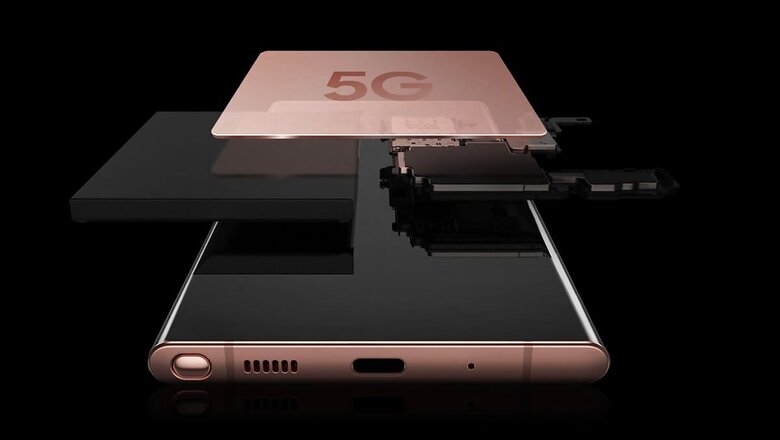
views
It is easy for forget the times gone by. Yet, more often than not, it is the history that guides us into the future. That is where the clues hide. In pain sight. It most certainly has, as far as home broadband is concerned. The evolution of home broadband in India, from around a bit more than a decade ago where 128kbps and 256kbps internet lines were considered high-speed, to the present day where 1Gbps connections are available for home users at prices that don’t really seem exorbitant at all. Yet, for the humble wire that was snaking into our home, plugged into a router and sitting unloved in a dusty corner for many years, home broadband has become as important as food, water and the air we breathe, because of the Coronavirus pandemic. You cannot be expected to get work done from home using a mobile hotspot from the often unreliable 3G or 4G connectivity that your phone latches on to.
The Telecom Regulatory Authority of India (TRAI) data suggests India has clocked 19.02 million wired broadband subscribers as of April. One suspects that number only went up in the subsequent months, as more folks like you and I realised the need for stable broadband connectivity during work from home. The pandemic provided the push towards adoption, something that was happening in the past, but clearly not fast enough. Over the past couple of years, speeds have gone up, subscription prices have come down, you get a bundle of value additions with your broadband subscription and there is now a premium hue to the service experience. It is merely a coincidence that we are also reaching the landmark of 25 years of Internet in India, at this juncture. A bit bittersweet, as they say. But what next for broadband in India?
First and foremost, there is expected to be a cut in the license fee for broadband services, particularly the wireline broadband services. From the present 2.5% of the adjusted gross revenue, it is expected that the government will reduce that to Re 1 of the AGR. That would mean significantly more money will be left with broadband companies. This could provide a boost to investment in installing fibre networks across the areas of service and most broadband companies may also pass on a part of the benefit to consumers in the way of making subscriptions a bit more affordable. Either way, a win-win for the broadband services in the country. In July, it was reported that China is also looking to significantly cut the fee levied on broadband companies, to reduce the costs for companies.
We must look at the future of internet connectivity and quality of services with the assumption that the coronavirus pandemic will still disrupt our lives for the next few months at least, if not years. Yet, return to normalcy could take even longer. We have attempted to map out the present state of home broadband in India (You can read that here), and a lot has to do with the ability to work remotely, do Zoom calls seamlessly, allow your child to attend an online class, online gym classes and of course, Netflix and Amazon Prime Video binging to stay sane after a maddening day remotely work.
A lot changed in 2018 when Reliance officially launched the Jio Fiber broadband service. We often credit Jio for changing the very landscape of mobility services in India with affordable prices and quality of 4G network coverage. The data suggests since Jio Fiber made its way into the home broadband market, rivals have had to really get their act together. Fiber is the way forward, and Airtel’s aggressive push with the Xstream fiber broadband plans over the past 12 months is an indication of the winds of change. Players such as Spectra and ACT are investing heavily in upgraded fiber networks for reliability and quality of service.
Yet, at the same time, a lot of the home broadband’s fortunes will be tied in with the mobile networks. There will be significant pressure on mobile networks to up their game, as a parallel stable connectivity option. At this time, India’s mobile networks don’t really have much to be proud of. According to Ookla’s Speedtest Global Index, India ranked 129 in the world in the mobile network speed stakes. That is behind Pakistan, Nepal, Zimbabwe, Uganda, Tanzania, and Libya, to name a few of the 128 countries above us. Average download speeds on 3G or 4G networks in India, if you are really lucky? 12.16Mbps. And upload speeds, in case you want to quickly share some files on a Google Drive link with colleagues? A measly 4.35Mbps.
This puts even greater emphasis on 5G. That is where Jio is expected to make the biggest difference again, and right on cue India has gotten its biggest 5G push, yet. At the Annual General Meeting (AGM) keynote last month, Reliance Industries confirmed that they are working on an indigenous 5G mobile network solution which will be ready for trials next year.
The impact of faster mobile networks will be felt across the board. The Indian government, with its ‘Make in India’ campaign is pushing to make India a global manufacturing hub. “5G in India is expected to provide the network to keep these factories connected real time with suppliers and customers, thereby making them smarter and much more efficient – the factories of the future,” says Deloitte in its “5G: The Catalyst to Digital Revolution in India” report. Remote medicine, virtual banking, more 4K and 8K content streaming subscriptions, Augmented Reality (AR), IoT, Big data analytics and Artificial Intelligence will all get a boost because of faster internet around us. Be it at home, or be it while we are on the move. Wired or wireless.
Reliance Jio says it is developing a 5G mobile network solution from the ground up, which will eliminate the need for the company to depend on third-party vendors including Huawei. There are plans to export this home-grown solution to mobile networks globally. The investment by technology giant Qualcomm could give Reliance Jio the technological advantage in the push for a new 5G mobile network solution. “Jio has designed and developed a complete 5G solution from scratch. It will be ready for trials as soon as 5G spectrum is available and can be ready for field deployment next year,” said Mukesh Ambani, Chairman and Managing Director of Reliance Industries.
This push by Jio for 5G was much needed. India is trailing behind most developed countries in the race for 5G networks. According to network testing provider VIAVI, as of January this year, 5G networks were available in 378 cities across 34 countries. As of that time, South Korea led the way with coverage in 85 cities, China followed with 5G networks in 57 cities, US with 50 5G ready cities and UK already has more than 31 cities with 5G mobile networks. India has some serious catching up to do.
India could do well to avoid the mistakes of the decade gone by. Where regulatory hurdles, spectrum pricing disagreements, licensing fees, penalties and other overhead costs bogged down home broadband and mobile network expansion and upgrades alike. In particular for 5G, where the ecosystem around the expected networks is already building itself, block by block. And that includes 5G in smartphones, a capability that most recent smartphone launches have, and something that will only become more common in the coming months. Users are ready. Let us get the networks going.
Editors' Note: This article is part of the 25 Years of Internet In India series, where try to capture how the state of mobile services, home broadband, services and content have evolved, particularly in the past few years. We try to understand what the internet means for us, be it for the new reality of work from home, for entertainment including all the Netflix binge watching, music streaming, online gaming and more.















Comments
0 comment